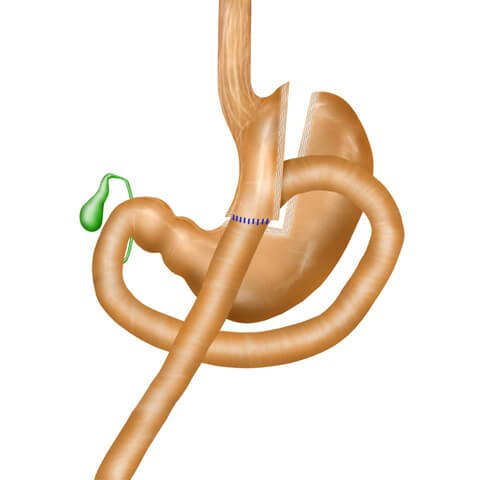Get immediate info for our deals and offers
Mini Gastric Bypass
What is MINIBYPASS?
It is a relatively new procedure that provides satisfactory results in terms of weight loss over the long term.
The stomach is divided into two parts, one large and one small. While the large part of the stomach is no longer in use, the small part acts like the patient's new stomach. Most of the stomach remains "active" but is no longer used.
The bypass process: How much of the small intestine is bridged depends on the patient. Normally you calculate between 90cm and 180cm. The intestine is transported to the small stomach, where it is attached and the two are surgically joined together. In contrast to the Roux-Y gastric bypass, the small intestine is never completely severed, but connected to the new stomach.
How to lose weight with mini bypass?
• The new little stomach created during mini gastric bypass reduces the amount you will eat.
• By reducing the size of the stomach, the level of ghrelin hormones, which makes you feel hungry, decreases. As a result, you don't want to eat as much or as often as you did before.
• With bypass surgery, food can bypass the part of the small intestine that is responsible for absorbing high molecular weight such as carbohydrates and fat. Because part of the small intestine is skipped, fewer calories are absorbed, which contributes to more weight loss.
How is the mini bypass operation performed?
The operation is performed under general anesthesia using a laparoscopic (closed) technique. With the help of laparoscopic instruments, a two-centimeter incision is made in the abdomen, placing a camera and instruments. The stomach is separated by sewing and cutting at the same time with the help of tools called staplers and steel staples.
The mini bypass operation is ideal in those cases:
Patients with a body mass index (BMI) of 40 and higher,
BMI between 35 and 39.9 is a serious health problem (type 2 diabetes, high blood pressure, severe sleep apnea, etc.).
If your obesity has emerged from excessive alcohol consumption or sugary foods, we may recommend gastric bypass surgery.
How long does the operation take?
Dr. Aynacı does not prefer to operate on the day the patient arrives. The operation is performed the following day. After the patient is taken to the operating room, it takes 30 minutes to fall asleep under general anesthesia for the surgical materials and positioning to be prepared. Dr. Aynacı can only start the operation after 30 minutes. The operation itself takes an average of 60-75 minutes. The patient takes about 15 minutes to wake up. The total duration of the operation is 2.5 hours. When the operation is over, the patient wakes up in a single room, where professional staff will take care of them in the best possible way.
What is the advantage of the mini gastric bypass compared to the Roux-Y gastric bypass?
The mini gastric bypass is less invasive compared to the Roux-Y gastric bypass. Gastric bypass is more destructive.
With mini gastric bypass the intestine is not cut and only has a connection between the new stomach and the intestine. With the Roux-Y gastric bypass the intestine is severed and has connections between the stomach and the intestine itself. This makes it possible to set up the mini bypass in a shorter time and this also reduces the risks and complications of mini gastric bypass.
When it comes to weight loss, weight loss and health benefits are roughly the same for both interventions.
It should be said that the vitamin deficiencies seen in minibypass patients are not as pronounced as in Roux-Y gastric bypass patients.
Again, MGB patients have a lower "dumping syndrome" than RYGB patients and a lower degree of severity.
If necessary, a mini gastric bypass can be set to a standard bypass. Roux-Y gastric bypass is not a reversible process. It's a permanent operation. There is no chance of a second operation.
Risks of the operation
There are generally always risks involved in surgical interventions. However, obesity surgery itself is not particularly dangerous. Information about the techniques used, the materials used, and the general health of the patient will reduce the risk of surgery. Dr. Aynacı uses all tools and materials only once. The material used is from Medtronic (Covidien) and is made in America. The risk of mini gastric bypass and Roux-Y gastric bypass is almost the same.
In rare cases, intestinal blockages due to damage to important organs or vessels, bleeding, infections from internal or external wounds, peritonitis, leakage from anastomoses, stenoses, wound healing problems, dumping syndrome, thrombosis and embolism, gastrointestinal disorders, allergies and internal hernias come.
| Treatment Details | |
|---|---|
| Cost from | € 3600 |
| Anesthesianesthesia | General Anesthetic |
| Duration of Treatment | 90-150 Minutes |
| Hospitalization | 4-5 Days |
| Return to Work | 2 weeks after the operation |




